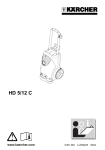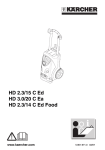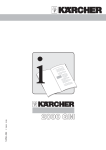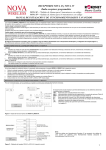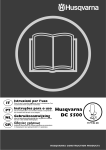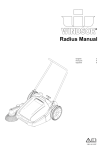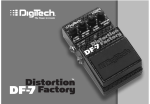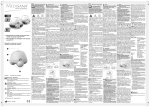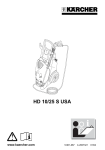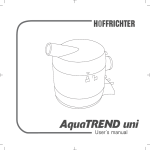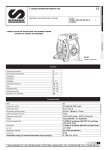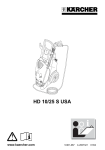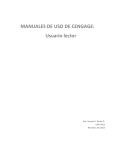Download 2200 GM
Transcript
5.956–393 F 19695 10/95 2200 GM English 2 2200 GM 2200 GM English English Page 4 Please read these operating instructions before starting and strictly observe the "Safety Instructions for High Pressure Cleaners". Español Página 12 Antes de poner en marcha el aparato deberá estudiar atentamente las "Advertencias y observaciones relativas a la seguridad para limpiadoras de alta presión". 3 English 4 2200 GM 2200 GM 1 2 3 4 5 6 7 8 9 10 11 12 13 14 15 16 1. Unit Start-Up Spray lance with pressure regulator Spray lance extension Hand gun Safety catch Push handle Basket for detergent reservoir Detergent suction hose with filter and metering ring Pull-start handle Throttle lever Tank cap Oil drain plug High-pressure hose High-pressure outlet Hose coupling Water inlet with strainer Oil filler hole with dipstick 1.1 Unpacking the unit l Should you notice any transport damage during unpacking, notify your dealer immediately. l Because you care about the environment, please do not dispose of packaging components in regular domestic waste. Instead, take the items to a collection point for recycling. 1.2 Attaching the accessories l Mount the holding basket for the detergent (3 metal hoops) to the push handle. l Attach the push handle to the unit. English 1.4 Pump l The pump is filled with oil. An oil change is not required. – FIRE HAZARD! Do not operate the highpressure cleaner if fuel has been spilled. Instead, move the machine to a different location and avoid creating sparks of any kind. – Do not store, spill or use engine fuels near open flame or in the vicinity of devices featuring an open pilot flame, such as boilers, water heaters, etc., or device that may create sparks of any kind. – Keep flammable items and materials away from the engine silencer (minimum distance: 2 meters). – Do not operate the motor without the silencer, and check and clean the latter on a regular basis. Replace if necessary. – Do not use the motor in woods, scrubs and grasslands without having a spark catcher attached to the silencer. – Except during engine tuning, do not operate the engine with the air cleaner removed, or without a suitable cover over the air intake. – Do not make adjustments to governor springs, governor linkages or other parts that may result in a higher engine RPM. – BURN HAZARD! Do not touch hot silencers, cylinders or cooling fins. – ASPHYXIATION HAZARD! Exhaust fumes are poisonous. Never operate the unit in enclosed rooms. 1.3 Engine l Prior to using the unit, read the operating instructions supplied by the engine manufacturer, and pay particular attention to the safety instructions. l Fill the fuel tank with unleaded petrol. Do not use a petrol/oil mixture for two-stroke engines. l The engine is supplied without engine oil. A certain amount of engine oil is packaged with the unit. Pour this engine oil into the oil filler hole on the engine. l Check the engine oil level. Do not start the engine if the oil level has dropped below the „MIN“ level. Top up oil if necessary. For draining the engine oil, the front cover of the pump must be removed. 5 English 1. Unit Start-Up 1.5 Water inlet l See „Specifications“ for connection data. l Connect the hose coupling with the threaded water inlet on the unit. l Connect a water supply hose (not supplied with the unit) with the unit, and with the water mains. 1.6 Suction feed operation To draw water from an open reservoir, proceed as follows: – Remove the threaded coupling from the unit’s water inlet, and directly connect a suction feed hose with filter (order no. 4.440-238) to the water inlet. – Set the metering ring on the detergent suction hose to zero. – Without the high-pressure hose being attached, operate the pump until a solid stream of water exits at the high-pressure outlet. – At this point, connect the high-pressure hose again. Note: Dirt in the feed water could lead to the appliance being damaged. To avoid this risk, we recommend fitting a filter. A suitable filter with 3/4" connection. 1.7 Spray lance l To attach the spray lance to the hand gun, insert the spray lance into the bayonet coupling of the hand gun. Overcoming the spring pressure, firmly press the lance into the coupling and twist it a quarter-turn until it locks into place. If required, you can use the additional spray lance extension. 6 2200 GM 2200 GM 2. Operation 2.1 Operating with high pressure l Start the engine while observing the engine manufacturer’s operating instructions. l Using the safety catch, unlock the handgun trigger and pull the trigger. l The working pressure can be variably adjusted by turning the spray lance on the outside (+/-). We recommend the following cleaning method: Step 1: Pre-soaking the area to be cleaned. Spay the detergent sparingly onto the area to be cleaned and allow to soak for 1 – 4 minutes. Step 2: Cleaning step Using the high-pressure jet, flush the area clean. l 2.2 Operating with detergent l Set the lowest working pressure with the spray lance. No detergent can be drawn in with a high working pressure. l Hang the detergent suction hose into the detergent reservoir (not supplied with the unit). l To protect the environment, we recommend to use detergents sparingly. Observe the metering and/or mixing instructions provided on the pakkaging labels of the detergent supply containers. l By offering you an individualised range of cleaning and preserving agents, Kärcher guarantees trouble-free operation of the unit. Request more information or ask for our catalogue and/or individual information brochures on specific detergents. Universal cleaner Profi RM 555 ASF This cleaning agent may be used undiluted. Universal cleaner Profi RM 555 ULTRA Automotive cleaner Profi RM 555 ULTRA House and garden cleaner Profi RM 565 ULTRA Boat cleaner Profi RM 575 ULTRA Before using, these cleaning agents must be diluted with 9 parts of water (1:9). English After using a detergent, the unit should be flushed with clean water. To do this, hang the detergent suction hose into a container filled with clean water, and operate the pump for approximately 1 minute. 2.3 Work interruptions l To prevent damage caused by overheating water, switch OFF the pump during work breaks that are longer than 15 minutes. 2.4 Switching OFF the unit l After operating the unit with water having a high saline content (i.e., sea water), the unit should be flushed for 2 – 3 minutes with tap water while the handgun is open. l Set the throttle to the STOP position. l Close the water supply valve and unscrew the water supply line from the water inlet of the unit. l Actuate the handgun trigger until the unit is no longer pressurised. l Prevent inadvertent opening of the handgun trigger by locking it with the safety catch. Note: Only cleaning agents approved by the equipment manufacturer may be used. Unsuitable detergents may damage the unit and the object being cleaned. 7 English 3. Care and Maintenance 3.1 Monthly or as required l Clean the filter on the detergent suction hose. l Clean the high-pressure nozzle. Using a needle, remove possible blockages from the nozzle orifice. Afterwards, flush with water from the front. l Clean the strainer in the water inlet. It can easily be pulled out with a pair of pliers. 2200 GM 3.2 Precautions in freezing temperatures l A unit that has not been completely drained may be damaged by water freezing inside the components. During the winter season, it is recommended to store the unit in a heated area. If this is not feasible, the unit should be completely drained and flushed with antifreeze. l Draining the unit – Remove the water feed hose and high-pressure hose from the unit. – Allow the unit to operate for a maximum 1 minute until the pump and the lines have been purged. l Antifreeze In the event that the unit is taken out of operation for extended periods, flushing the unit with an antifreeze is recommended. This practice also achieves a certain degree of corrosion protection. 4. Troubleshooting This chapter contains a few helpful hints which may help you remedy small defects without requiring further assistance. In all other cases please contact the authorised customer service. 4.1 Unit does not run l Perform the maintenance procedures on the engine as outlined in the operating instructions issued by the engine manufacturer. 4.2 Unit does not reach operating pressure l Set the spray lance to the maximum working pressure. l Clean the water inlet strainer. l Check the water supply volume. l Check all supply lines feeding the pump for possible leaks or blockage. 8 4.3 Strong pressure fluctuations l Clean the high-pressure nozzle. Remove dirt from the nozzle hole with a needle and then rinse out with water from the front. 4.4 Pump is leaking l Three drops per minute are normal. In the event that the exiting water volume is larger, contact the authorised customer service. 4.5 No detergent is being drawn in l Set the spray lance to the minimum working pressure. l Clean both the detergent suction hose and the filter, and check the hose for leaks. 2200 GM 5. General Information English 5.1 Possible applications 5.3 Warranty – Use the unit for cleaning machines, vehicles, buildings, tools, etc. The applicable warranty conditions in different countries are issued by the respective national distributor of products. During the warranty period, any malfunctions of the unit caused by a material or manufacturing defect will be repaired free of charge. In the event of a warranty claim, please take the unit, with proof of purchase, to your original dealer, or to the nearest authorised customer service centre. – For example, clean facades, terraces, and garden implements, etc. with the high-pressure jet only. – For reasons of environmental protection, engines may only be cleaned in locations equipped with suitable oil separators. – In the event that the unit is used at petrol stations and in other hazardous areas, the appropriate safety regulations must be observed. – For the removal of stubborn dirt, we recommend the use of the dirt blaster which is available as an optional accessory. 5.2 Safety devices Safety Valve/Overflow valve The safety valve also serves as the overflow valve. When the hand gun is closed, the valve opens and water is returned to the suction side of the pump. 9 English 6. Specifications Engine Data Briggs & Stratton Petrol engine 1 Cylinder, four-stroke Nominal output at 3600 RPM ........................................... 3.6 kW 5.0 HP Operating RPM ..................................................................... 150 r.p.m. Fuel tank capacity .................................................................. 0.4 gal Fuel type ............................................................................ petrol unleaded Sound pressure level (45635) ................................................. 87 dB (A) Sound power level ................................................................ 100 dB (A) Water connection Supply temperature (max.) ................................................... 140 °F Supply rate (min.) ................................................................... 2.6 g.p.m. Supply hose (Order no. 4.440-207) - length (min.) ...................................................................... 25 ft - diameter (min.) ................................................................. 3/4 " Suction height from open tank at a water temperature of 20 °C/68 °F .................................... 39 in Performance data Operating pressure ............................................................. 1750 psi Flow rate ................................................................................ 2.2 g.p.m. Detergent intake .................................................................. 0 – 8 g.p.h. Recoil force of handgun at operating pressure (max.) ................................................... 23 N Dimensions Length ..................................................................................... 21 in Width ....................................................................................... 15 in Height ...................................................................................... 39 in Weight without accessories .................................................... 55 lbs 10 2200 GM Español 12 1750 GM 1750 GM 1 2 3 4 5 6 7 8 9 10 11 12 13 14 15 16 1. Puesta en marcha Lanza con regulación de la presión Prolongación de lanza Pistola Seguro contra accionamiento involuntario de la pistola Asa Soporte para el depósito del detergente Manguera del detergente con filtro y dosificación Dispositivo para arranque manual Palanca del acelerador Tapa del depósito de combustible Tornillo de purga del aceite Manguera de alta presión Conexión (salida) de alta presión Acoplamiento de manguera Toma de agua con filtro Boca de llenado del aceite con varilla medidora de nivel 1.1 Desembalar el aparato l Si al desembalar el aparato comprobara Vd. algún daño o desperfecto en el mismo atribuible al transporte, rogamos se dirija inmediatamente al Distribuidor en donde adquirió su aparato. l No tire el embalaje del aparato y sus elementos al cubo de basura. Entréguelo en los Puntos o Centros Oficiales de recogida para su reciclaje o recuperación 1.2 Montar los accesorios l Montar el soporte para el depósito del detergente (3 estribos de chapa) sobre el asa del aparato. l Montar el asa en el aparato. 1.3 Motor l Antes de poner en marcha el aparato deberán leerse las instrucciones de servicio del fabricante de los motores y observarse asimismo los consejos y advertencias de seguridad. l Llenar el depósito del combustible con gasolina sin plomo. No utilizar en ningún caso mezcla para motores de dos tiempos. l El motor se suministra con el depósito de aceite vacío. Rellenar el aceite que se suministra con el aparato en la boca de llenado del motor. l Español Verificar el nivel del aceite del motor. No poner el aparato en marcha en caso que el nivel del aceite se encontrara por debajo de la marca de mínimo nivel de llenado. En caso necesario, rellenar aceite. Para vaciar el aceite hay que retirar la tapa delantera de la bomba. 1.4 Bomba l La bomba está llena de aceite. No es necesario cambiar el aceite. – No trabajar con la limpiadora de alta presión en caso de haberse derramado combustible (gasolina). Retirar la máquina del lugar. ¡Evitar cualquier formación de chispas hasta que no se haya evaporado el combustible! – No guardar, derramar ni manipular el combustible cerca de fuentes de fuego abierto o de aparatos tales como estufas, calderas, calentadores de agua, etc. que posean llama de encendido o puedan originar chispas. – Mantener alejados (distancia mínima 2 m) los objetos o materiales fácilmente inflamables del colector de escape. – No operar el motor sin silenciador. Revisar regularmente el estado del silenciador. Verificarlo, limpiarlo o sustituirlo por uno nuevo en caso necesario. – No trabajar con el aparato en áreas o zonas recubiertas de bosque, matorrales o hierba si no se ha equipado el tubo de escape del aparato con un parachispas. – No hacer funcionar el motor sin el filtro de aire o sin la tapa sobre la boca de aspiración, con excepción de los trabajos de ajuste. – No efectuar reajustes ni modificaciones en los muelles de ajuste, varillajes del regulador u otras piezas o elmentos susceptibles de elevar el número de revoluciones del motor. En caso de unos regímenes de revoluciones excesivamente elevados, el motor puede sufrir graves desperfectos. – No tocar los silenciadores, cilindros o aletas de refrigeración que estuvieran calientes. ¡Peligro de quemaduras! – El aparato no deberá funcionar en espacios o recintos cerrados. ¡PELIGRO DE INTOXICACION! 13 Español 1. Puesta en marcha 1.5 Circuito de alimentación de agua l Observar los valores de conexión que se describen en las características técnicas del aparato. l Montar el acoplamiento para la manguera en la toma (entrada) del aparato. l Empalmar una manguera para la alimentación de agua (no está incluida en el equipo de serie) al aparato y a la conexión (grifo) de agua de la red. 1.6 Servicio de aspiración En caso de aspirar agua desde recipientes abiertos, deberán observarse estrictamente las instrucciones y normas de la empresa abastecedora de agua de la zona. – Retirar el racor de acoplamiento de la toma de agua del aparato y acoplar directamente al aparato una manguera de aspiración con filtro (Nº de pedido 4.440-238). – Ajustar el anillo de dosificación en la manguera de aspiración del detergente a la posición «0». – Hacer funcionar la bomba, sin acoplar la manguera de alta presión, hasta que el agua salga sin burbujas de aire en la salida de alta presión del aparato. – Empalmar la manguera de alta presión al aparato. Advertencia: Obsérvense estrictamente las instrucciones y normas de la empresa abastecedora de agua de la zona. Según la normativa alemana DIN 1988, la limpiadora de alta presión no puede acoplarse a la red pública de abastecimiento de agua potable, a fin de evitar que los detergentes y agentes químicos puedan acceder y contaminar el agua potable. Un acoplamiento de breve duración a través de un dispositivo de bloqueo anti-retorno, sin embargo, está permitido. La suciedad disuelta en el agua de alimentación puede dañar el aparato. Con objeto de evitar esta situación, aconsejamos emplear un filtro para el agua, acoplamiento 3/4". 1.7 Lanza con regulación de la presión l Encajar la lanza, haciendo presión contra la fuerza del muelle, en el acoplamiento de bayoneta de la pistola y girarla en un ángulo de 90°, hasta que enclave. 14 1750 GM 1750 GM 2. Manejo del aparato 2.1 Servicio de alta presión l Poner en marcha el motor según las instrucciones de servicio facilitadas por el fabricante del motor. l Desbloquear la pistola a través del seguro contra accionamiento involuntario y oprimir la palanca de accionamiento de la pistola. l La presión de trabajo se puede ajustar de modo continuo, girando la lanza hacia el exterior (+/-). Método de limpieza aconsejado: Primer paso: Separar la suciedad Pulverizar el detergente en cantidad mdoerada sobre la superficie u objeto a limpiar y dejar que actúe durante 1 a 4 minutos. Segundo paso: Eliminar la suciedad Eliminar la suciedad separada con el chorro de agua de alta presión. l 2.2 Pulverización del detergente l Ajustar la lanza a baja presión de trabajo. Con alta presión no se puede aspirar detergente. l Introducir la manguera de aspiración del detergente en el depósito del detergente (no incluido en el equipo de serie de la limpiadora). l En interés de la protección del medio ambiente, recomendamos hacer un uso muy moderado de los detergentes. l Disponemos de una amplia gama individual de detergentes y agentes conservantes, por lo que podemos garantizar el funcionamiento seguro y correcto de su aparato. No dude en consultarnos o solicite nuestro catálogo general o las hojas informativas específicas sobre detergentes. Detergente universal Profi RM 555 ULTRA Detergente específico para turismos Profi RM 565 ULTRA Detergente específico para el hogar y jardín Profi RM 570 ULTRA Detergente específico para embarcaciones Profi RM 575 ULTRA Estos detergentes tienen que ser diluidos en agua en la proporción de 1:9 (1 parte de detergente, 9 partes de agua). Advertencia: Sólo deberán utilizarse aquellos detergentes recomendados u homologados por el Fabricante. Unos detergentes inapropiados pueden causar daños en el aparato y en el objeto a limpiar. Español Una vez finalizados los trabajos con un detergente deberá enjuagarse el aparato con agua limpia. Para ello se introduce la manguera de aspiración del detergente en un recipiente con agua limpia, haciendo funcionar la bomba durante 1 minuto aproximadamente. 2.3 Interrupción del funcionamiento del aparato l En caso de estar el aparato inactivo durante unos períodos de prolongados (más de 15 minutos), deberá desconectarse la bomba a fin de evitar daños por el sobrecalentamiento del agua. 2.4 Desconexión del aparato l Tras haber trabajado con agua salada (del mar), enjuagar la limpiadora con agua de red (limpia), con la palanca de accionamiento de la pistola oprimida, durante un período mínimo de 2-3 minutos. l Colocar la palanca del acelerador en la posición de parada «STOP». l Cerrar la alimentación de agua (grifo) y desempalmar la manguera de alimentación de agua del aparato. l Oprimir la palanca de accionamiento de la pistola hasta que el aparato quede totalmente sin presión. l Conectar el seguro contra accionamiento involuntario de la pistola. 15 Español 3. Trabajos de cuidado y mantenimiento 3.1 Mensualmente o según necesidad l Limpiar el filtro en la manguera de aspiración del detergente. l Limpiar la boquilla de alta presión. Eliminar las obstrucciones en la boquilla con ayuda de una aguja. Enjuagarla con agua limpia de dentro hacia afuera. l Limpiar el filtro en la toma de agua del aparato. El filtro se extrae con ayuda de unos alicates de boca plana. 1750 GM 3.2 Protección contra heladas l Los aparatos que no hayan sido vaciados completamente de agua o por cuyo interior no se haya hecho circular una solución de agente anticongelante, pueden sufrir daños a consecuencia de las bajas temperaturas. Por eso aconsejamos guardar el aparato durante la estación invernal en una nave o espacio protegido contra las bajas temperaturas (provisto de calefacción). l Vaciado del aparato – Desempalmar las mangueras de alimentación de agua y de alta presión del aparato. – Hacer funcionar el aparato durante 1 minuto como máximo, hasta haber evacuado completamente el agua de la bomba y las tuberías. l Adición de anticongelante Para largos períodos de inactividad del aparato, aconsejamos la aplicación de agente anticongelante, dado que de este modo también se logra una cierta protección contra la corrosión. 4. Localización de averías En el prsente capítulo queremos facilitarle una serie de consejos que le permitirán subsanar por sí mismo perturbaciones y averías de menor importancia. En caso de averías de mayor envergadura deberá avisarse al Servicio Postventa Oficial. 4.3 En el aparato se producen fuertes oscilaciones en la presión l Limpiar la boquilla de alta presión. Eliminar con ayuda de una aguja las obstrucciones que pudieran existir en la boquilla y enjuagarla con agua (de dentro hacia afuera). 4.1 El aparato no se pone en marcha l Revisarlo y efectuar los trabajos de mantenimiento tal y como se explica en las instrucciones de servicio del fabricante del motor. 4.4 l Inestanqueidades en la bomba Unas fugas del orden de 3 gotas por minuto son admisibles. En caso de registrarse unas fugas mayores, avisar al Servicio Postventa Oficial. 4.2 El aparato no coge presión l Ajustar la máxima presión de trabajo en la lanza. l Limpiar el filtro en la toma de agua del aparato. 4.5 No se produce aspiración de detergente l Verificar el caudal de alimentación de agua. l Ajustar la lanza a la mínima presión de trabajo. l Verificar la estanqueidad de las tuberías de alimentación hacia la bomba. Verificar asimismo si presentan obstrucciones. l Limpiar la manguera de aspiración del detergente con filtro. Verificar su estanqueidad. 16 1750 GM 5. Advertencias y consejos de carácter general Español 5.1 Aplicación del aparato 5.3 Garantía – El aparato ha sido diseñado para la limpieza de máquinas, vehículos, edificios, herramientas, etc. En cada país rigen las condiciones de garantía establecidas por las correspondientes Sociedades Distribuidoras. Las perturbaciones y averías de su aparato serán subsanadas de modo gratuito en la medida en que las causas de las mismas sean debidas a defectos de material o de fabricación. En un caso de garantía rogamos se dirija, con el aparato y los accesorios, así como el comprobante de compra del mismo, al Distribuidor en donde adquirió el aparato o a la Delegación Oficial del Servicio Postventa más próxima. – Limpiar fachadas y exteriores de edificios, terrazas, aparatos de jardinería, etc. sin detergentes, sólo con el chorro de alta presión. – Por razones de protección medioambiental, la limpieza de motores sólo puede efectuarse en aquellos puntos y zonas que estén dotadas del correspondiente separador de aceite. – En caso de emplear el aparato en gasolineras y estaciones de servicio, o en zonas de peligro, habrá que observar las correspondientes normas de seguridad. – Para la eliminación de suciedad particularmente resistente y fuertemente adherida, aconsejamos utilizar nuestra boquilla rotativa con ‘efecto fresadora’. 5.2 Dispositivos de seguridad Válvula de seguridad/Válvula de derivación La válvula de seguridad es al mismo tiempo una válvula de derivación. Al dejar de oprimir la palanca de accionamiento de la pistola, la válvula abre y el agua vuelve a las válvulas de aspiración de la bomba. 17 Español 6. Características Técnicas Potencia y rendimientos del motor Motor Briggs & Stratton, monocilíndrico, de gasolina, cuatro tiempos Potencia nominal a 3.600 r.p.m. ..............................................3,6 kW 5,0 HP Número de revoluciones de servicio del motor .......................... 3150 r.p.m. Capacidad del depósito de combustible ........................................ 0,4 gal Combustible .......................................................................... gasolina sin plomo Nivel sonoro según norma DIN 45635 ........................................... 87 dB (A) Nivel de potencia acústica ............................................................ 100 dB (A) Conexión a la red de agua Máx. temperatura del agua de alimentación ................................ 140 °F Caudal de alimentación ................................................................. 2,6 g.p.m. Manguera de alimentación (Nº de pedido 4.440-207) - Longitud (mín.) .......................................................................... 25 ft - Diámetro (mín.) ........................................................................ 3/4 " Altura de aspiración del agua desde un recipiente abierto a una temperatura de 20°C ................................................ 39 in Potencia y rendimientos Presión de trabajo ....................................................................... 1750 psi Caudal ............................................................................................ 2,2 g.p.m. Aspiración de detergente ............................................................ 0 – 8 g.p.h. Fuerza de retroceso a máxima presión de trabajo ............................................................. 23 N Medidas del aparato Longitud .......................................................................................... 21 in Altura ............................................................................................... 15 in Altura ............................................................................................... 39 in Peso sin accesorios ........................................................................ 55 lbs 18 1750 GM

















